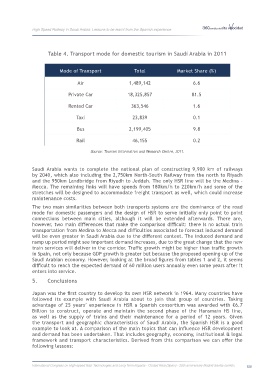Page 527 - 360.revista de Alta Velocidad - Nº 6
P. 527
High Speed Railway in Saudi Arabia: Lessons to be learnt from the Spanish experience
Table 4. Transport mode for domestic tourism in Saudi Arabia in 2011
Mode of Transport Total Market Share (%)
Air 1,489,142 6.6
Private Car 18,325,857 81.5
Rented Car 363,546 1.6
Taxi 23,839 0.1
Bus 2,199,405 9.8
Rail 46,155 0.2
Source: Tourism Information and Research Centre, 2011.
Saudi Arabia wants to complete the national plan of constructing 9,900 km of railways
by 2040, which also including the 2,750km North-South Railway from the north to Riyadh
and the 950km Landbridge from Riyadh to Jeddah. The only HSR line will be the Medina –
Mecca. The remaining links will have speeds from 180km/h to 220km/h and some of the
stretches will be designed to accommodate freight transport as well, which could increase
maintenance costs.
The two main similarities between both transports systems are the dominance of the road
mode for domestic passengers and the design of HSR to serve initially only point to point
connections between main cities, although it will be extended afterwards. There are,
however, two main differences that make the comparison difficult: there is no actual train
transportation from Medina to Mecca and difficulties associated to forecast induced demand
will be even greater in Saudi Arabia due to the different context. The induced demand and
ramp up period might see important demand increases, due to the great change that the new
train services will deliver in the corridor. Traffic growth might be higher than traffic growth
in Spain, not only because GDP growth is greater but because the proposed opening-up of the
Saudi Arabian economy. However, looking at the broad figures from tables 1 and 2, it seems
difficult to reach the expected demand of 60 million users annually even some years after it
enters into service.
5. Conclusions
Japan was the first country to develop its own HSR network in 1964. Many countries have
followed its example with Saudi Arabia about to join that group of countries. Taking
advantage of 25 years’ experience in HSR a Spanish consortium was awarded with €6.7
Billion to construct, operate and maintain the second phase of the Haramain HS line,
as well as the supply of trains and their maintenance for a period of 12 years. Given
the transport and geographic characteristics of Saudi Arabia, the Spanish HSR is a good
example to look at. A comparison of the main topics that can influence HSR development
and demand has been undertaken. That includes geography, economy, institutional & legal
framework and transport characteristics. Derived from this comparison we can offer the
following lessons:
International Congress on High-speed Rail: Technologies and Long Term Impacts - Ciudad Real (Spain) - 25th anniversary Madrid-Sevilla corridor 525

